This is the website of Abulsme Noibatno Itramne (also known as Sam Minter).
Posts here are rare these days. For current stuff, follow me on Mastodon
|
We’re still in the phase where the pollsters ask about many candidate combinations. With the most recent polling in Ohio, there is no change in the Clinton vs Trump status, but there were changes to Clinton vs Rubio and Clinton vs Cruz. In both cases, the Republican position improves, and Clinton gets a little weaker.
Clinton vs Trump
No, this didn’t change, but since these are the two frontrunners, just a quick reminder of where that race stands:
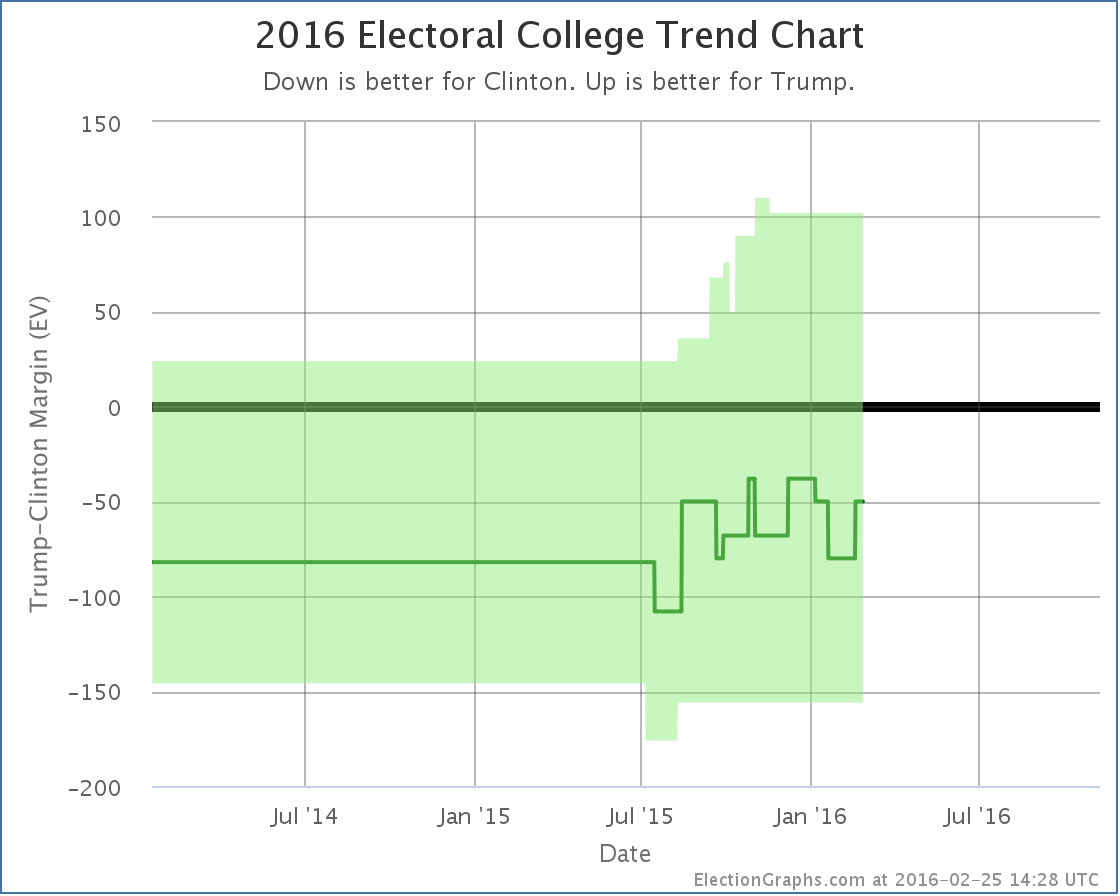
Anything from Clinton winning by 156 electoral votes to Trump winning by 102 electoral votes is plausible given the state polls. Clinton winning by 50 electoral votes is the “expected” result if each candidate wins all the states they are ahead in right now.
Clinton vs Rubio
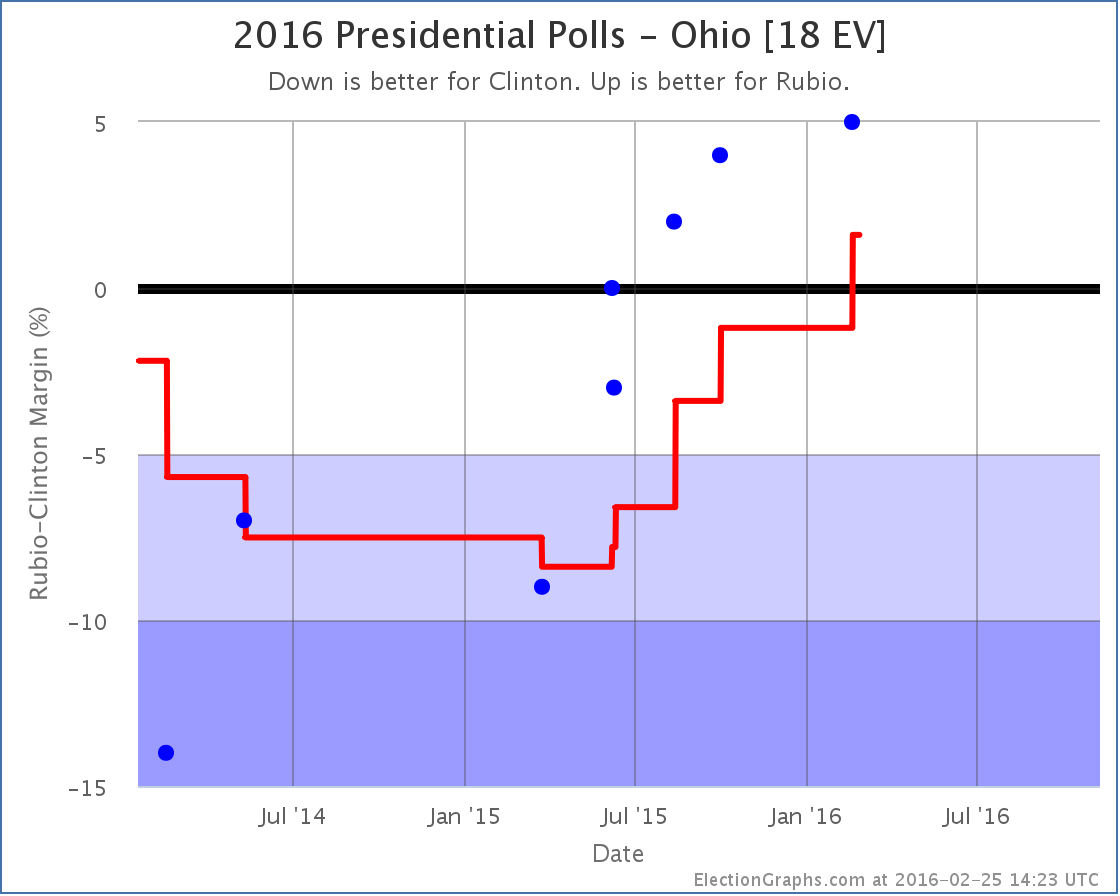
Ohio has been polled less often than one might expect for a state that is traditionally in the “swing state” category, and which looks like it might be again. But the polls for the last year or so have been trending in Rubio’s direction. With this poll, the average pops into the plus side for Rubio. He now leads in Ohio by 1.6% in the average. To be clear, that is still a very close race. But he now has the advantage, so we put Ohio on his side of the ledger.
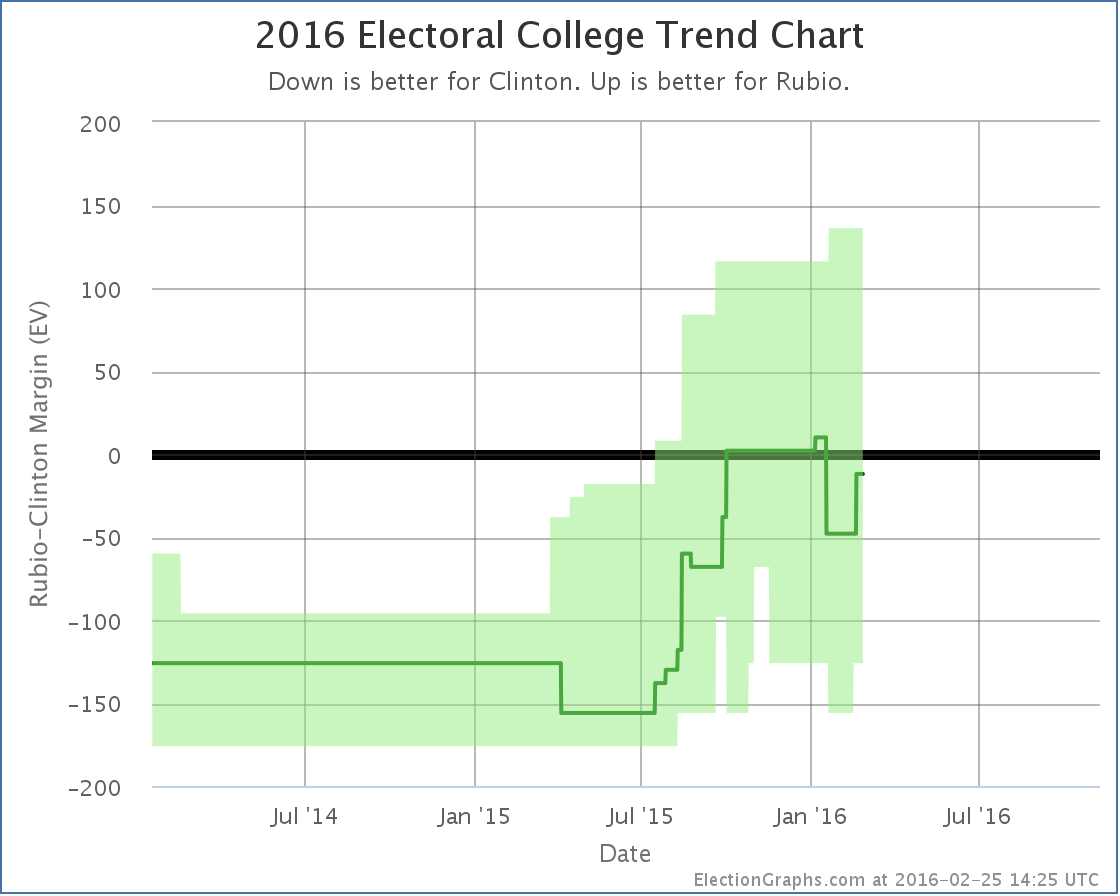
With Ohio back in his column again, if Rubio won every state he is ahead in, and Clinton won every state she is ahead in, Rubio would fall just 12 electoral votes short. He’s not back to leading the race yet, but it is very close. Flipping any one of Florida (0.2% Clinton lead), Virginia (1.2% Clinton lead), Minnesota (1.5% Clinton lead), Michigan (2.9% Clinton lead), or Nevada (4.5% Clinton lead) would do it.
With the large number of close states, anything from Clinton winning by 126 to Rubio winning by 136 would not be surprising though.
Clinton vs Cruz
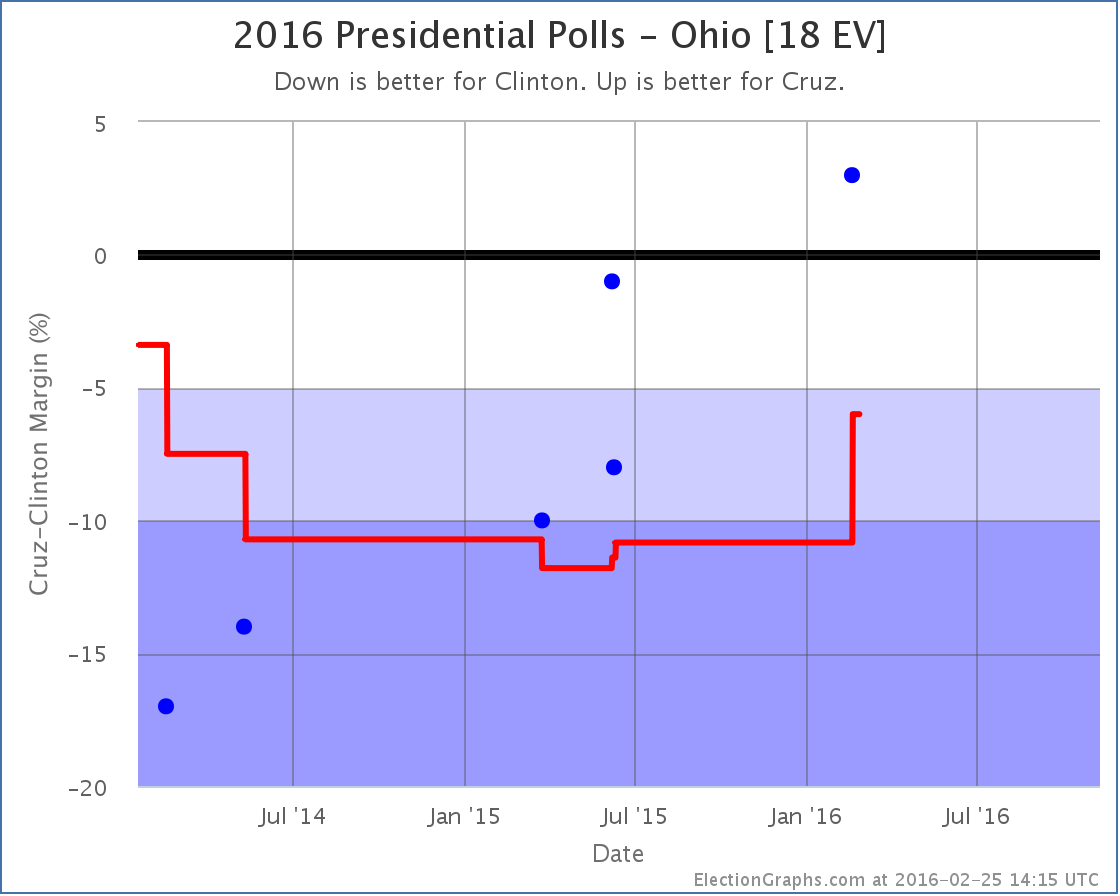
Cruz hasn’t managed to make Ohio competitive against Clinton yet, she still leads him by 6.0% in the poll average, but because with this update Ohio moved past the previous “tipping point state”, the tipping point here moves a bit toward Cruz.
As a reminder, the tipping point is the margin in the state that would put the winning candidate “over the edge” in the electoral college if you order the states by how strongly they support the candidates. Like this:

Prior to this update, the tipping point in Clinton vs Cruz had been Florida, where Clinton led by 6.6%. Now the tipping point is Virginia, where Clinton leads by 6.4%.
The tipping point is essentially like looking at the national popular vote, except it takes into account the structure of the electoral college. It tells you how far the polls would have to move across the board in all states to flip the winner.
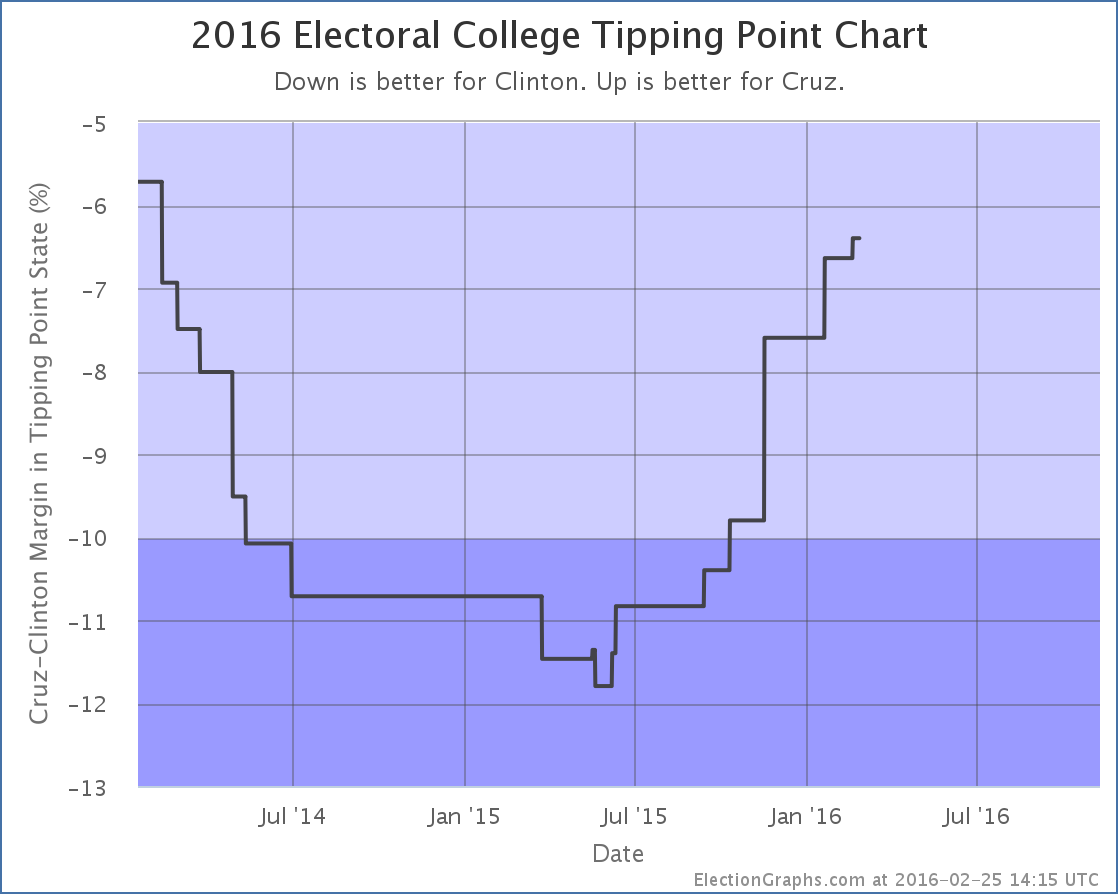
Cruz trails Clinton by 6.4% in this metric… but he has slowly but surely been improving his position since last May. It would take a bit more movement before he actually looked competitive with Clinton though.
And that is where things are today.
256.7 days until polls start to close on election night.
Note: This post is an update based on the data on ElectionGraphs.com. Election Graphs tracks both a poll based estimate of the Electoral College and a numbers based look at the Delegate Races. All of the charts and graphs seen in this post are from that site. Additional graphs, charts and raw data can be found there. All charts above are clickable to go to the current version of the detail page the chart is from, which may contain more up to date information than the snapshots on this page, which were current as of the time of this post. Follow @ElectionGraphs on Twitter or like Election Graphs on Facebook to see announcements of updates or to join the conversation. For those interested in individual general election poll updates, follow @ElecCollPolls on Twitter for all the polls as they are added.
Sanders needed to win 20 of the 35 delegates available in Nevada’s caucuses to be on a pace to catch up with Clinton and win the Democratic nomination. He did not get 20. He got 15. Clinton got 20. There was some talk from the Sanders camp about how much closer Nevada was than it looked like it would be a few weeks ago. That is true. But in the end, the result is Clinton getting 57% of the delegates while Sanders gets 42%.
So Sanders falls further behind. Lets look at the charts.
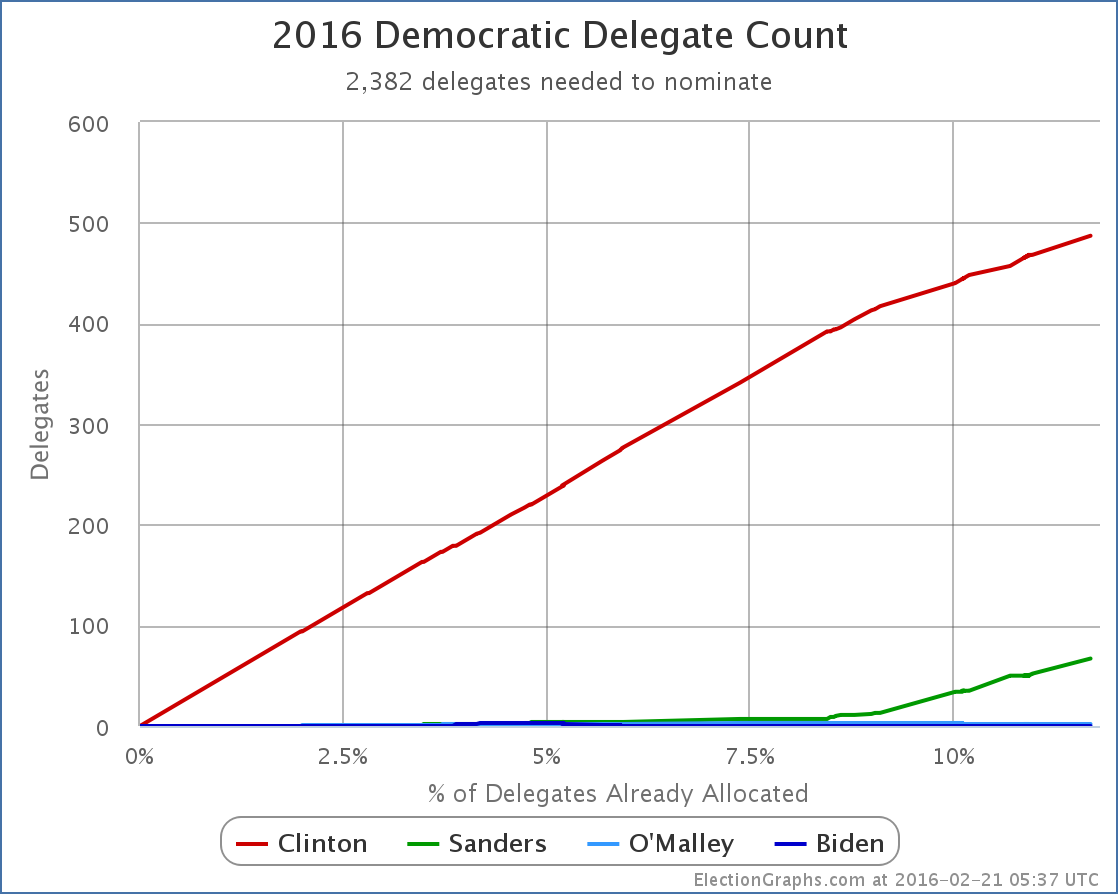
First the straight up delegate counts. We are now at Clinton 487, Sanders 67, O’Malley 2.
In addition to the delegates from the Nevada caucuses, since my last update on the 14th when 42 superdelegates were added for Clinton there have been other updates contributing to those numbers. That includes a number of new delegates identified as being for a candidate, a couple delegates who had been identified as being for a candidate saying explicitly that they considered themselves to be neutral, a few double counting errors corrected, and even one superdelegate dying. The net result was 6 more delegates for Clinton and 2 more for Sanders. And I gave O’Malley back 2 superdelegates who despite his dropping out have not yet stated another preference. In general these changes are backdated to the date there is evidence for them, rather than being dated as of the time I find the change.
Add those all up, and since New Hampshire, Clinton’s total has increased by 68 delegates while Sanders gained 17. If you don’t count the delegates that changed before New Hampshire that I found out about after New Hampshire, it is still 30 Clinton delegates to 17 for Sanders.
Either way, Clinton continues to accumulate delegates faster than Sanders does. That is not a recipe for Sanders catching up. To catch up, Sanders needs to either be getting supermajorities of the delegates from primaries, caucuses and currently unpledged superdelegates, or he needs to be getting quite a few current Clinton superdelegates to defect. So far neither of those things have been happening.
(Note: AP and CNN have Clinton’s delegate totals even higher, presumably due to some non-public superdelegate commitments they know about but haven’t published. The above counts are mostly using superdelegate counts from Wikipedia except for a handful of cases where I have deviated for specific reasons where I believe I have a better count.)
So, how is the “% of remaining delegates needed to win” looking?
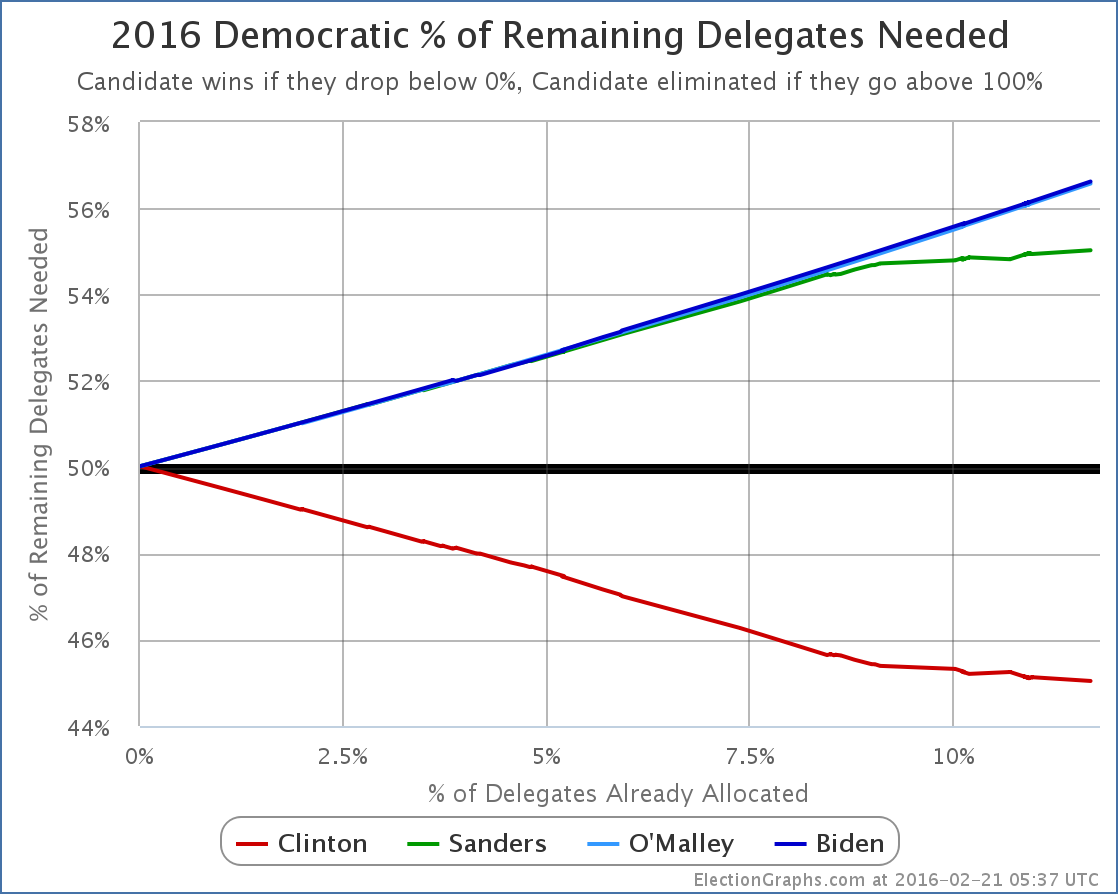
Since Sanders has not been making his percentages, and Clinton has, Clinton’s line is slowly dropping, and Sanders’ is slowly rising. Slowly is the watchword here though. Sanders is now up to 55.03%. Right before Iowa, this was at 54.22%. (Counting the postdated delegates, 54.72%.) Sanders hasn’t done well enough that he is actually catching up with Clinton, but he has done well enough to keep the movement on this number low. He is ALMOST keeping Clinton from making progress. Almost but not quite.
As more delegates get racked up, assuming Sanders continues to collect less than 55% of the delegates, it will not only get harder and harder to catch up to Clinton, it will also get harder and harder to prevent that red line from zooming downward to zero, the point where Clinton wraps up the nomination.
For now though, while he isn’t stopping her, Sanders is clearly slowing Clinton down more than she would like.
Next up, South Carolina.
Update 2016-02-26 15:55 UTC – Completed a scan for superdelegate changes. Net result is +6 Clinton superdelegates… plus one new O’Malley superdelegate. This is not actually a NEW O’Malley superdelegate, but one that declared their support back in November but just hadn’t been logged yet, and there is not yet evidence of them stating they are now uncommitted or backing another candidate. These changes have no substantive effect on the analysis above.
Update 2016-02-28 03:24 UTC – Another scan for superdelegates in preparation for adding in South Carolina results. Net result Clinton +4, Sanders +1. This again has not substantive effect on the analysis above, but putting a note here since it is not worth a blog post of its own.
Note: This post is an update based on the data on ElectionGraphs.com. Election Graphs tracks both a poll based estimate of the Electoral College and a numbers based look at the Delegate Races. All of the charts and graphs seen in this post are from that site. Additional graphs, charts and raw data can be found there. All charts above are clickable to go to the current version of the detail page the chart is from, which may contain more up to date information than the snapshots on this page, which were current as of the time of this post. Follow @ElectionGraphs on Twitter or like Election Graphs on Facebook to see announcements of updates or to join the conversation. For those interested in individual general election poll updates, follow @ElecCollPolls on Twitter for all the polls as they are added.
Edit 17:17 UTC to add note about AP and CNN delegate counts.
General Election state polls have been few and far between since we are in the heart of the primary battles, but we did get a new PPP North Carolina poll and when it gets factored into my poll averages, it resulted in a couple of category changes worth noting:
Clinton vs Trump

As you can see, North Carolina has been bouncing between “Weak Clinton” and “Weak Trump” ever since there was substantial polling here for Clinton vs Trump in the fall. With this latest update to the average, North Carolina flips back into Trump’s column.
The reality here is that regardless, North Carolina looks close, and could easily go either way, but it moves the center “expected” line in our chart showing the range of plausible electoral results:

Trump’s “Expected” case, where he wins every state where he leads the poll average, and loses those where he doesn’t, is to lose to Clinton by 50 electoral votes. Trump remains well within reach though. If he were to take the lead in only Iowa, Ohio, and Michigan he would take an electoral college lead. If he were to take all the close states, he would end up winning by 102 electoral votes.
Clinton vs Rubio

Rubio has been doing substantially better in North Carolina than Trump. Rather than bouncing around near the zero line, this has been hovering near the 5% line that I use to separate “Weak Rubio” from “Strong Rubio”. This update pushes the average to a lead just barely over 5%, so I remove North Carolina from the list of possible Clinton pick up states. This does not change the “expected” results, but diminishes Clinton’s “best case” scenario where she wins not only the states she currently leads, but also those where she is behind by less than 5%.

So Clinton’s best case goes from winning by 156 electoral votes, to only winning by 126 electoral votes. The “expected” result remains a 48 electoral vote win by Clinton given the states where she leads in the poll averages.
Once we get clear winners in the primary races, I expect we will stop seeing polling for any candidate combination other than those winners, and general election polling should speed up again. In the mean time, most of the action is going on in the delegate races. Before long though, attention will move back to the general election, and there will be plenty to watch on this side of things too.
262.3 days until the first general election polls start to close.
Note: This post is an update based on the data on ElectionGraphs.com. Election Graphs tracks both a poll based estimate of the Electoral College and a numbers based look at the Delegate Races. All of the charts and graphs seen in this post are from that site. Additional graphs, charts and raw data can be found there. All charts above are clickable to go to the current version of the detail page the chart is from, which may contain more up to date information than the snapshots on this page, which were current as of the time of this post. Follow @ElectionGraphs on Twitter or like Election Graphs on Facebook to see announcements of updates or to join the conversation. For those interested in individual general election poll updates, follow @ElecCollPolls on Twitter for all the polls as they are added.
On this week’s Curmudgeon’s Corner podcast Sam and Ivan do indeed talk a lot about Election 2016 and all of the developments there, but there is other news this week too! So first off is a discussion of Apple vs the FBI, then an analysis of the battle following Justice Scalia’s death. Oh, and you get the story of Sam’s drive from Seattle to San Francisco, and a bit about the limitations of video streaming too!
Click below to listen or subscribe… then let us know your own thoughts!

Recorded 2016-02-19
Length this week – 2:16:56
 1-Click Subscribe in iTunes 1-Click Subscribe in iTunes
 View Podcast in iTunes View Podcast in iTunes
 View Raw Podcast Feed View Raw Podcast Feed
 Download MP3 File Download MP3 File
 Follow the podcast on Facebook Follow the podcast on Facebook
Show Details:
- (0:00:10-0:31:57) But First
- Sam in a Hotel
- Agenda
- New Microphone
- Internet Quality
- Sam’s Drive
- (0:32:37-0:54:55) Apple vs FBI
- The Order
- Why Apple Refused
- Why is FBI pushing this case?
- What if Apple loses?
- What if Apple wins?
- Industry Implications
- Slippery Slope
- Politicians and Encryption
- (0:55:58-1:21:14) Death of Justice Scalia
- Ivan’s doppelgГ¤nger
- The news breaks, people go nuts
- Republican Senate says don’t even nominate
- Higher stakes that previous vacancies?
- Recess Appointment?
- Does this damage Senate Republicans?
- Who does Obama pick?
- Hypocrisy?
- Will the wall hold until January?
- Impact of 4-4 Court
- (1:22:34-1:40:01) Election 2016 – Democrats
- Upcoming Contest Schedule
- Nevada Polls
- Election Graphs Comment
- Superdelegates
- Possible paths for Sanders
- (1:40:50-2:08:09) Election 2016 – Republicans
- The Latest Debate
- Polling Update
- Gaming out the next states
- Trump trying to lose?
- Trump lawsuit threats
- Trump’s RNC Deal
- Trump and the Pope
- (2:09:18-2:16:36) Lightning Round
- Obama going to Cuba
- Steaming Video
Since the New Hampshire primary, I have seen a flurry of Facebook posts and numerous articles all over the place, first by people suddenly shocked to learn of the existence of superdelegates, then folks complaining about the DNC “screwing over” Sanders, and then folks claiming superdelegates should be ignored because they don’t matter. All this in response to places, like my site electiongraphs.com, that point out Clinton’s huge lead due to superdelegate counts.
My current chart of raw delegate totals looks like this:
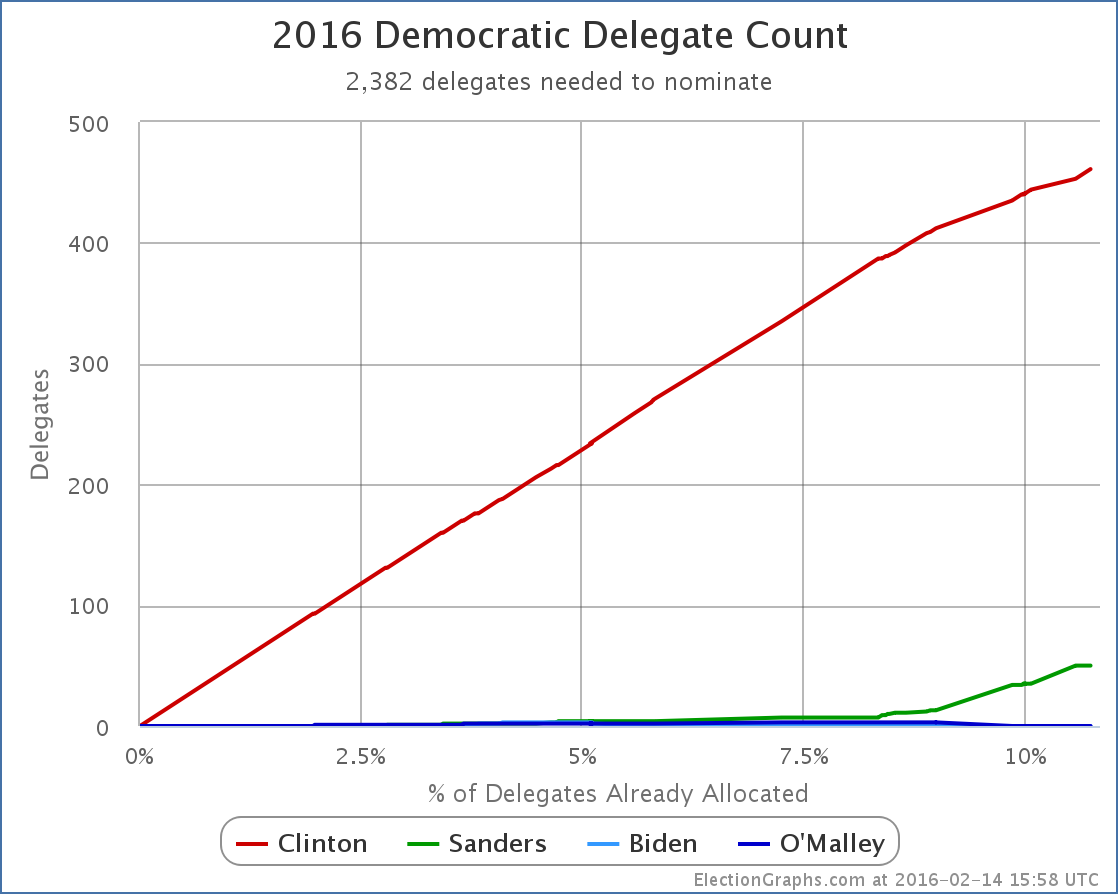
That is Clinton 461 to Sanders 50 including the latest updates that prompt this post.
The claim is that the Clinton lead here is a complete illusion. That counts that look like this are simply anti-Sanders propaganda meant to discourage Sanders voters, that looking at numbers like this is meaningless, and one should only look at “pledged” delegates, where the total right now would be Sanders 36, Clinton 32. That would indeed show a very different picture of the race. Sanders would actually be winning!
But really? Would that tell us where the race really is?
First of all, there isn’t any secret or underhanded manipulation. There are 32 delegates in New Hampshire. 24 of them were to be determined by the primary. Of these Sanders won 15 and Clinton won 9. Some of those are determined proportionately in each congressional district, some proportionately by the statewide results. Those numbers come straight from the votes. Just math.
Then there were also 8 “super delegates”. That is one Senator, one Representative, one Governor, and five members of the DNC. These are eight people who have names and have been known for ages. Six of those eight had declared they supported Clinton long before the primary. The other two haven’t publicly stated a preference yet. That means the delegate total in New Hampshire is now 15 to 15 with 2 not yet determined.
The Sanders folks might not like that, or like the existence of super delegates at all, but none of this is new or an unexpected manipulation or anything, it is simply how the race is structured. A lot of people are expressing shock because they are just now realizing this, but it is no surprise to anyone familiar with the Democratic primary process, and certainly Sanders’ campaign staff is quite familiar with it.
As we’ve chronicled here, Clinton started out with nearly 8% of the national convention delegates already in her column before the first votes were even cast in Iowa and New Hampshire. She has been working on cultivating those people since at least 2013, probably earlier. Sanders managed to get a handful of these folks, but not many. So he started out way behind, and had to get over 54% of the remaining delegates to be on a pace to catch up and win. A majority wasn’t good enough.
It isn’t a good spot to be in for him, and you might argue that super delegates shouldn’t exist. Yes, superdelegates were originally created and exist to give the party apparatus some buffer against a popularly supported insurgency, and that sounds like Sanders. But the superdelegates have existed for decades and they are a known part of the process.
So complaining about them at this point is along the same lines as complaining about the electoral college. The person complaining might be right that in some ways a straight popular vote would be more “fair”, but these were the rules of the game and anybody running knew the rules when they chose to play.
It wasn’t superdelegates specifically that made the difference, but remember that in 2008, Hillary Clinton won the popular vote in the Democratic primary process.* It was only the structure of the delegate race that won Obama the nomination. Because those were the rules of the game. That is still the case today. And that includes superdelegates.
OK, fine, but what about the fact that super-delegates can change their minds? Their votes aren’t locked in stone, and they certainly wouldn’t want to overturn the results if a candidate was winning all the contests and had a majority of the non-super delegates, right? So since they can change their minds and will probably support “the winner” we should ignore them, right?
Indeed, it is important to note that the super-delegates are real people and complete free agents. They can and do change their minds. And yes, superdelegates may be reluctant to be the deciding factor in a close race, but you can’t really say “the super delegates would do X”. It is 712 individual humans, who will each decide on their own what they want to do.
Many superdelegates have yet to express a preference at all and can probably be fairly easily swayed. They have not expressed an opinion for a reason, and may well go either way. Others have publicly supported Clinton, but it could be weak support and maybe they could be flipped if they were actually courted. Many others are actually actively working on the Clinton campaign in prominent state level roles. People in this last category are unlikely to change their votes unless or until Clinton herself drops out and asks them to. At the very extreme, Bill Clinton is a superdelegate. Is he going to vote for Sanders?
You really do have 712 different people, with 712 different reasons for their preferences, and 712 different degrees of how strongly they support their candidate.
If Sanders was serious about the superdelegates, he and his surrogates wouldn’t be pushing talking points about how superdelegates don’t matter and will vote for the popular winner so they should be ignored. Instead he would be heavily lobbying the currently uncommitted superdelegates to start backing him. They are a constituency to be courted. They are an IMPORTANT constituency to be courted.
If you were to see such movement, the first place you would detect it would probably be a higher percentage of currently uncommitted superdelegates raising their hands for Sanders when they do come out and reveal a preference.
Superdelegates who have already publicly stated they are supporting Clinton will probably not start actually flipping back to uncommitted or to Sanders until or unless things are actually looking very dire for Clinton.
If you do end up seeing Sanders winning more contests than he loses and building up a big lead in the regular non-super delegates, you may start to see both kinds of movement. After all, people like backing a winner. But if it happens, you will actually see that change happening in the delegate counts if you watch this site or one of the other places that include superdelegates in the totals. It will not be invisible.
There is no sign of any such movement yet.
Can Sanders win without flipping any Clinton superdelegates over to his side? Yes, of course he can. It is a high bar, but it is within the realm of possibility. He just needs to get about 55% of the remaining delegates.
Can Sanders win with even a smaller portion of the remaining delegates? Why yes, of course he can, if he starts convincing Clinton delegates to change their minds. But if that is going to happen, they have to actually be convinced to do so. Here is a list. Go start lobbying them. Try to change their minds. But nobody should be assuming that is automatic.
Yes, if Sanders ends up leading the non-superdelegate count at the end of the primary season and superdelegates are the only thing putting Clinton over the edge, there will be extreme pressure on the superdelegates to flip. But they still have to actually do so. And most likely, when they start waffling on their positions, they will actually say so, and we will know.
The delegate counts including superdelegates are NOT misleading. You just have to interpret them correctly… meaning that you know superdelegates are actual human beings that can change their minds, and you think about what situations might lead that to happen. But ignoring that they exist and just assuming that of course they will change their minds is extreme folly. It is sticking your head in the sand and ignoring reality. It is willfully blinding yourself in order to believe in an illusion instead. If and when the superdelegates start changing their minds, we will see it. Until or unless that happens, Clinton really does have a huge delegate lead that Sanders would have to overcome in order to win.
Meanwhile, as the Sanders camp has been complaining about superdelegates and how they don’t matter, superdelegate movement to Clinton has continued. Since the New Hampshire Primary results, I’ve added 44 additional superdelegates to Clinton’s column. Not all of these actually announced their support this last week, some did so months ago, but I just found the references more recently. Their support gets backdated in the charts and graphs to the date of the public source documenting their support. I also removed 2 Clinton superdelegates that had been accidentlly double counted. Net gain, Clinton +42.
There were no new Sanders superdelegates.
So where does that put us on “% of remaining delegates needed to win”?
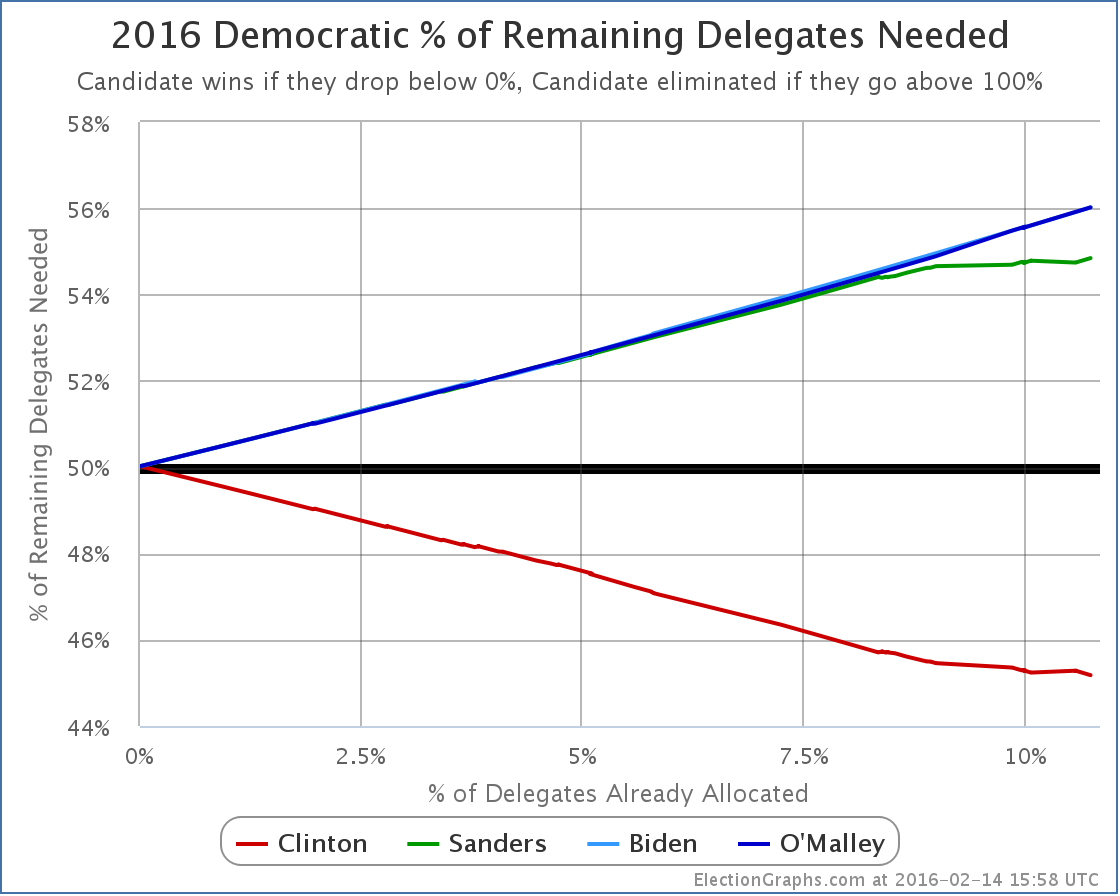
Clinton now needs only 45.18% of the remaining delegates to win.
Sanders needs 54.84%. Right before the Iowa caucuses, my best estimates were that sanders needed 54.22%. (Including pre-Iowa superdelegate preferences I know about now that weren’t included at the time, it would have been 54.65%.) So despite his close second in Iowa, and his win in New Hampshire, Sanders is worse off in the delegate race than he was before Iowa. But not by much… he has ALMOST been holding things steady. He needs to do better to catch up and win, but Iowa and New Hampshire are only a small portion of the overall delegates, so there is still a lot of room to maneuver.
The next delegate race is Nevada.
There are 35 delegates up for grabs in Nevada that will be determined by the caucuses there. Plus 8 superdelegates. Of these, 3 have already said they are for Clinton, and 1 has said they are for Sanders. So don’t be surprised when you see those added in at places showing the state delegate count. They aren’t part of the 35 determined by the caucus though.
Of the 35, Sanders needs to get 20 in order to be on a pace to catch up with Clinton. (Again, assuming no superdelegates change their minds, if a lot do, this number becomes lower.) The RCP average has Nevada at Clinton 47.5%, Sanders 36.0%. That certainly wouldn’t get Sanders the 20 delegates he needs, but that average only includes one post-New Hampshire poll, and that new poll shows the race tied. The Pollster average discounts the pre-New Hampshire results entirely and shows the race at 45% to 45%… a tie.
Delegate rules are tricky. In Nevada some delegates are determined at the congressional district level, others at the state level, there is rounding involved, etc, etc. It is also a multi-stage caucus process, not a primary, so the “real” delegate totals won’t be known until May. But we will have estimates.
Remember though that it is not that Sanders needs 54.84% of the popular vote. It is that he needs 20 of the 35 delegates. That is the number to watch.
And superdelegates of course. :-)
A final thought: It is very possible to catch up from a deficit. But catching up is much harder if you pretend you aren’t actually behind.
* It has been pointed out to me that this would likely not have been the case if Obama had, like Clinton, chosen to compete in Michigan despite DNC sanctions… Clinton essentially ran unopposed in Michigan and this margin was enough to put her in the lead in the national popular vote. If you do not include Michigan, Obama lead the popular vote in 2008. This does not however change the point, which was that there are many ways that the delegate rules can lead to results that differ from the popular vote, of which the superdelegates are only one.
Note: This post is an update based on the data on ElectionGraphs.com. Election Graphs tracks both a poll based estimate of the Electoral College and a numbers based look at the Delegate Races. All of the charts and graphs seen in this post are from that site. Additional graphs, charts and raw data can be found there. All charts above are clickable to go to the current version of the detail page the chart is from, which may contain more up to date information than the snapshots on this page, which were current as of the time of this post. Follow @ElectionGraphs on Twitter or like Election Graphs on Facebook to see announcements of updates or to join the conversation. For those interested in individual general election poll updates, follow @ElecCollPolls on Twitter for all the polls as they are added.
[Edit 18:06 to add link to Wikipedia superdelegate list.]
[Edit 18:48 to add final thought.]
[Edit 2016-02-16 06:50 UTC to add asterisk note about Michigan.]
This week on Curmudgeon’s Corner Sam and Ivan talk about chickens! Just kidding. Of course they talk about Election 2016. New Hampshire. Sanders beating Clinton. Trump walking all over the other Republicans. The log jam at second place on the Republican side. What this means for the delegate race and the next couple of states on both sides. Everything you would expect! Then they wrap it up with a lightning round for some thoughts on the Zika virus, changes on Twitter, the Oregon standoff, and more!
Click below to listen or subscribe… then let us know your own thoughts!

Recorded 2016-02-11
Length this week – 1:39:01
 1-Click Subscribe in iTunes 1-Click Subscribe in iTunes
 View Podcast in iTunes View Podcast in iTunes
 View Raw Podcast Feed View Raw Podcast Feed
 Download MP3 File Download MP3 File
 Follow the podcast on Facebook Follow the podcast on Facebook
Show Details:
- (0:00:10-0:16:41) Intro
- Pi Again
- Agenda
- Ivan’s Rough Day
- Sam’s Upcoming Trip
- (0:17:26-0:55:16) Election 2016: Republicans
- New Hampshire Results
- Upcoming contests
- Rubio’s debate crash
- Kasichmentum?
- Who drops out and when?
- Gaming out South Carolina
- anti-Trumps running out of time
- Trump moving to center?
- Trump/Sanders Swing Voters
- Fighting each other instead of Trump
- Carson in South Carolina!
- (0:56:25-1:19:52) Election 2016: Democrats
- No Surprise
- Delegate Story
- South Carolina and Nevada
- What is the path for Sanders?
- Clinton indictment?
- Sanders/Clinton demographics
- Independents
- Sam’s Choices
- Santorum iSideWith
- (1:20:41-1:38:40) Lightning Round
- Book: Prince Caspian
- Zika Virus
- Twitter Changes
- Ivan iSideWith
- Oregon Standoff
Lets jump right to it. In the last Democratic update we mentioned that to actually improve the “% of remaining needed to win” Sanders needed to get 54.36% of the delegates available in New Hampshire. That would be 14 out of 24 delegates that were available today. He got 15 out of 24, or 62.5% of yesterday’s delegates. So he did it!
In addition, since my last update, there were some superdelegate changes. The net change from those was +1 Clinton, +1 Sanders. There was also a net reduction of 1 available delegate, bringing the total number of Democratic delegates down to 4,763.
With all of that in place, here is the new chart for “% of remaining needed to win”:
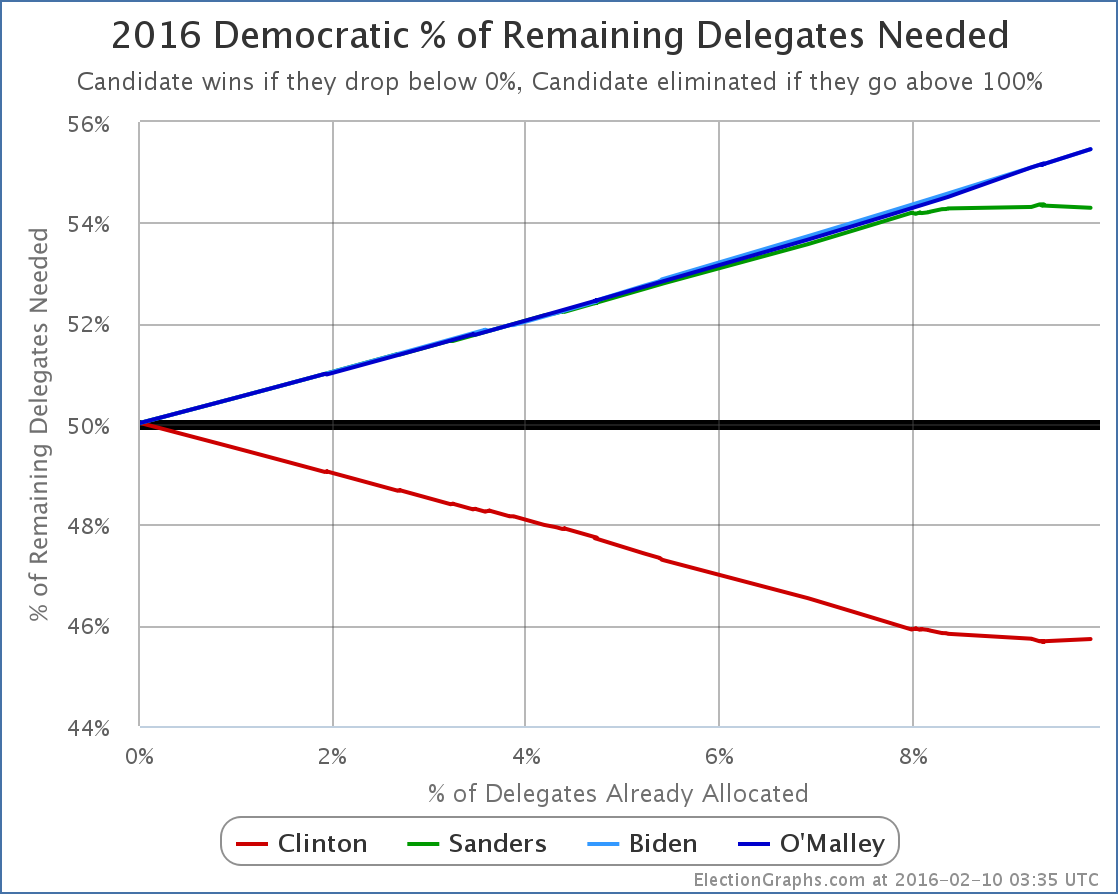
The Sanders % Needed has indeed gone down, and he made Clinton’s go up!
Sanders’ % Needed specifically moved from 54.36% to… 54.30%.
This was at 54.22% before Iowa. 54.30% matches where this was right after Iowa.
So, Sanders did improve his situation, but only enough to undo the superdelegate changes that happened after Iowa, not enough to get back even to where he was before the voting started.
Another way to look at this is to just look at New Hampshire itself. Of delegates allocated by the Primary, Sanders got 15 delegates to Clinton’s 9. But New Hampshire also has 8 superdelegates, and 6 of these had already declared for Clinton.
So the actual New Hampshire total as of today is 15 Clinton, 15 Sanders, 2 TBD.
So even with his big win, which was indeed a big win, Sanders actually has only pulled even in delegates in the state.
Now, of course, superdelegates can change their mind. It has been said that if one candidate was clearly leading absent superdelegates, the superdelegates would not go against them, and would start to change their minds and flip to the candidate leading in non-super delegates. Maybe. It could happen. And if it does, that movement will be tracked here. Certainly no such movement has been seen yet.
In the mean time, next up for the Democrats is Nevada on February 20th. Nevada often gets relatively little attention compared to South Carolina, but Nevada will actually be the next place where we see if Sanders is able to take his New Hampshire results and build anything longer term out of it.
Nevada is a caucus state, so delegates won’t actually be allocated on the 20th, but there will be results that can be used to estimate convention delegates. Nevada has 43 delegates. Of those 8 are superdelegates. Clinton already has 3 superdelegates in her column, Sanders has 1. Nevada’s caucuses will determine 35 delegates. 23 will be allocated based on results in the 4 congressional districts, 12 will be allocated based on the state wide results.
To once again have a result that keeps him on pace to catch up to Clinton and win, Sanders needs to get 20 of the 35 delegates available on caucus day, assuming no additional superdelegate declarations or other adjustments between now and then.
At the moment, Nevada poll averages show Clinton leading 50.0% to 30.5%… but there has been no polling there since December. Expect a variety of new polls in the next week. Watch them carefully. For Sanders to be on track, these numbers have to flip… and then Sanders has to build an even larger lead.
In South Carolina, a week after Nevada, Clinton is even further ahead, although again polls there are stale and new ones taken post-Iowa post-New Hampshire are eagerly awaited.
Between now and Nevada, and probably between now and South Carolina, there will be almost non-stop talk about Sanders’ threat to Clinton, how Clinton is a lot weaker than expected, how vulnerable she is. A lot of this is true. To a degree.
But to evaluate if Sanders is actually a threat to Clinton eventually taking the nomination, as opposed to just being a temporary speed bump in her way, Sanders has to not only take the lead in Nevada, South Carolina and beyond, but be ahead by a significant margin, not just a little bit. This is a tall order. Maybe it is possible.
But if there is talk about how Sanders is “closing the gap” or “making it closer than expected” in Nevada or South Carolina, keep in mind that isn’t enough. He needs to actually win and win by a large enough margin to get more than 54.30% of the delegates to be on pace to catch up and win. Otherwise, the task in later states just becomes even harder.
Note: This post is an update based on the data on ElectionGraphs.com. Election Graphs tracks both a poll based estimate of the Electoral College and a numbers based look at the Delegate Races. All of the charts and graphs seen in this post are from that site. Additional graphs, charts and raw data can be found there. All charts above are clickable to go to the current version of the detail page the chart is from, which may contain more up to date information than the snapshots on this page, which were current as of the time of this post. Follow @ElectionGraphs on Twitter or like Election Graphs on Facebook to see announcements of updates or to join the conversation. For those interested in individual general election poll updates, follow @ElecCollPolls on Twitter for all the polls as they are added.
Most attention right now continues to be on the primary races, as we are in the days between Iowa and New Hampshire, and things are still very unsettled and exciting. But there have been a handful of new general election polls. The latest change to mention is in the matchup between the delegate frontrunners in both parties.
Clinton vs Cruz
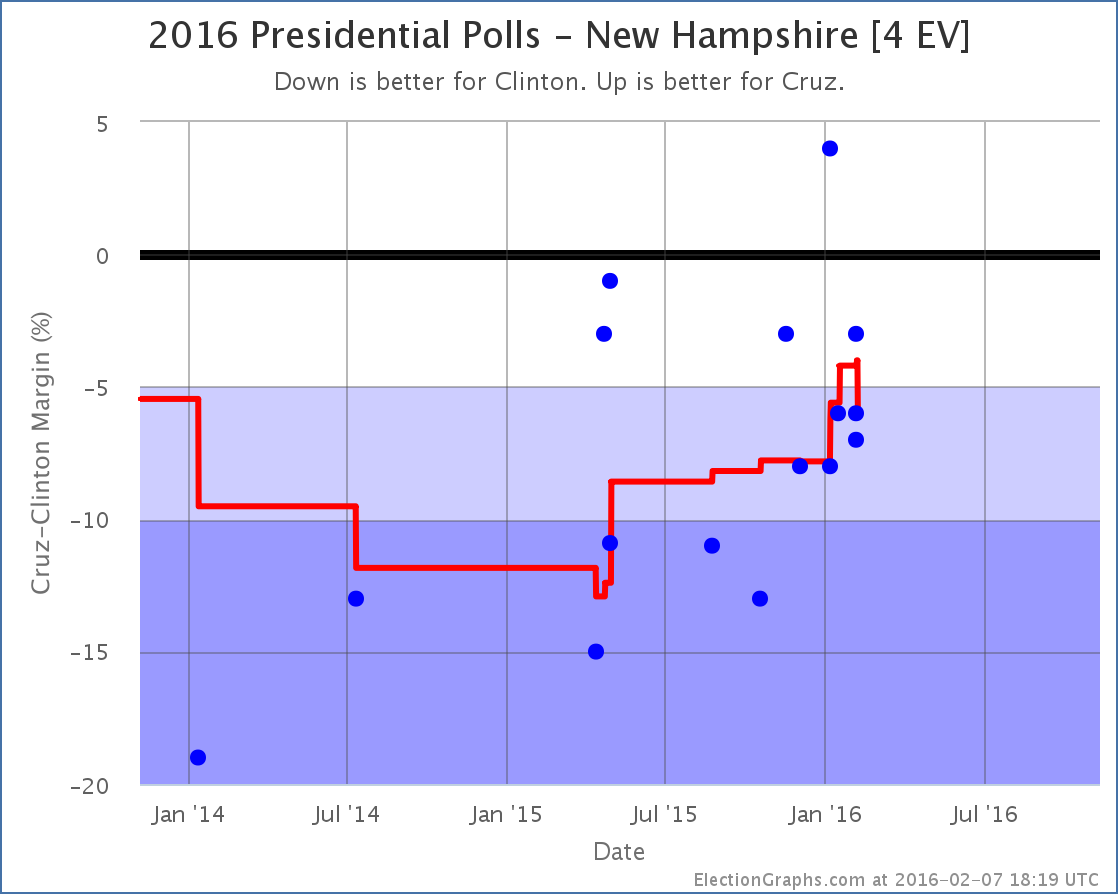
For a few short weeks, some favorable polls for Cruz moved New Hampshire from “Strong Clinton” to “Weak Clinton”, meaning that the poll average showed a Clinton lead of less than 5%, so we considered the state “possible” for Cruz and included it in Cruz’s best case.
In this update Clinton’s lead in the New Hampshire poll average against Cruz is back up to 6.0%, so New Hampshire seems like it is off the table for Cruz again.
This moves Cruz’s best case from losing to Clinton by 76 electoral votes to losing by 84 electoral votes. The “Expected” case where each candidate wins all of the states they are ahead in the poll average, with no states flipping, still has Cruz losing by 96 electoral votes.
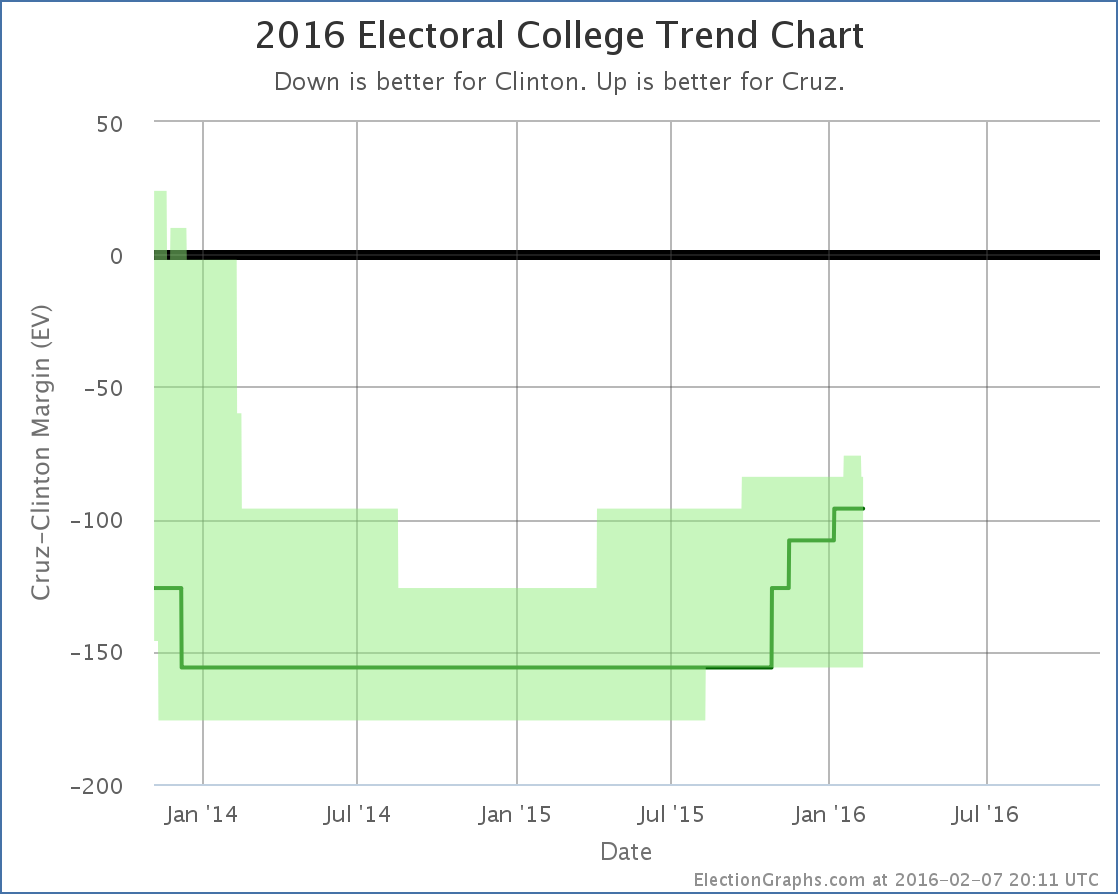
Cruz is well behind Clinton in these electoral college estimates. (Popular vote polling is more positive to him though.). But his best case, worst case, and expected case have all been improving over the last year. Today’s change is the first one in which his position has gotten worse since August 2014, which frankly was before there were enough polls to give a reliable picture.
The question is of course if this is a sign of additional movement to come. Is this the best that Cruz can do against Clinton? The popular vote numbers I pointed to earlier indicate that Cruz probably can indeed do better than this, and perhaps we’re not seeing it in the electoral college numbers just because we don’t have enough recent polling in enough states. Or maybe we really do have a popular vote / electoral college disconnect. It is possible.
In any case, it would be premature to think that Cruz has topped against Clinton. We have a very long way to go. If Cruz continues to be the Republican delegate frontrunner, or even close, we’ll continue to get more polling and a better picture of how a Clinton vs Cruz race would go, and of course things will look different once the general election campaign starts in earnest.
Of course, if Cruz falls behind in the delegate race, polling involving him will dry up in favor of whoever is leading in his place. And nobody will miss it. :-)
275.1 days until general election polls start to close!
Note: This post is an update based on the data on ElectionGraphs.com. Election Graphs tracks both a poll based estimate of the Electoral College and a numbers based look at the Delegate Races. All of the charts and graphs seen in this post are from that site. Additional graphs, charts and raw data can be found there. All charts above are clickable to go to the current version of the detail page the chart is from, which may contain more up to date information than the snapshots on this page, which were current as of the time of this post. Follow @ElectionGraphs on Twitter or like Election Graphs on Facebook to see announcements of updates or to join the conversation. For those interested in individual general election poll updates, follow @ElecCollPolls on Twitter for all the polls as they are added.
I’ve promised not to post every day there is an update of a superdelegate here or there. Instead, I’ll generally include them in the next post after an actual primary or caucus. However, if enough accumulate, I’ll go ahead and do a post just on superdelegates. There have been 10 superdelegate changes since my last post on the Democrats. That’s as good a threshold as any, so here is a quick update.
First of all, I probably should have made this change before that last post, but I didn’t… O’Malley dropped out on caucus night shortly after the results started coming in, as it was immediately clear that as expected he would not have a good night. If O’Malley had earned actual pledged delegates, they would remain in his column until such time as O’Malley formally released them. But these superdelegates are always free agents, and with O’Malley out, there is no reason to believe their previous endorsements of O’Malley still stand. So I zeroed out O’Malley’s three superdelegates. Goodbye O’Malley.
In addition, news reports showed 5 new Clinton superdelegates in Illinois, and 2 new Clinton superdelegates in Iowa.
So, net Change: Clinton +7, O’Malley -3.
New “% of remaining needed to win chart”:
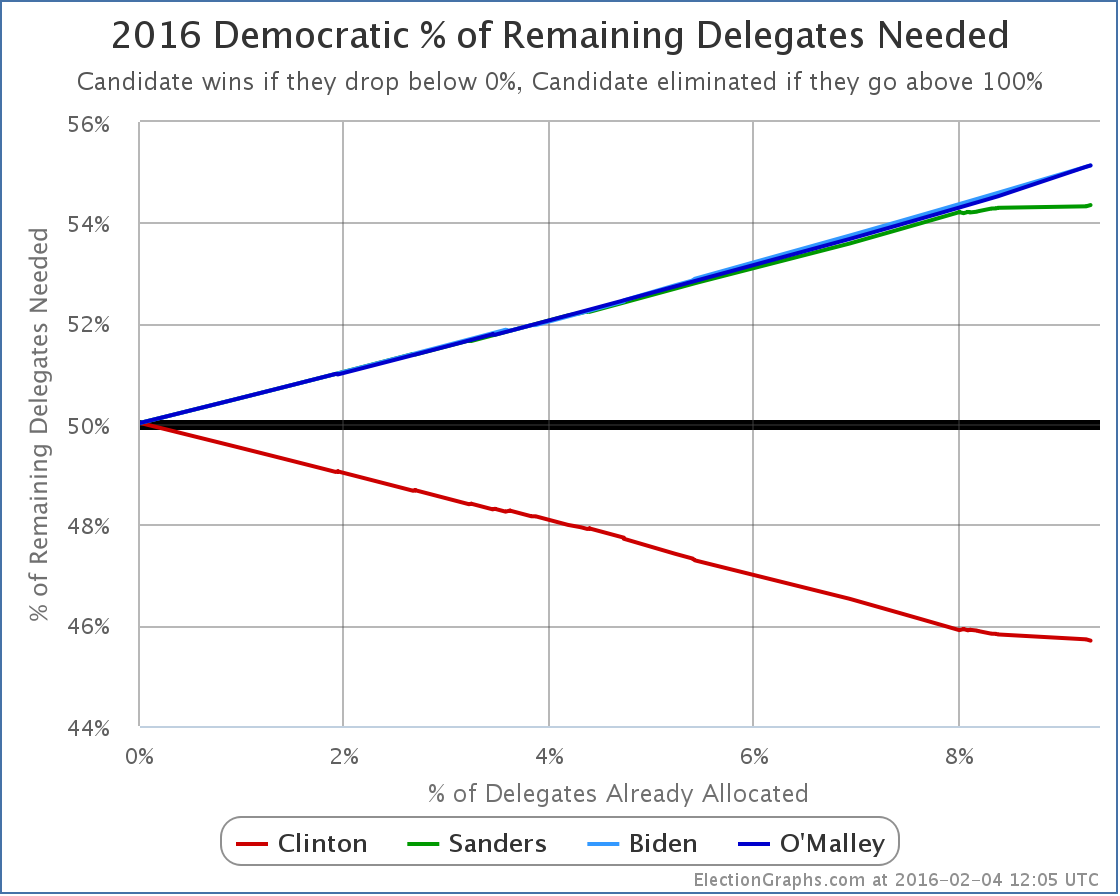
And the updated data chart:
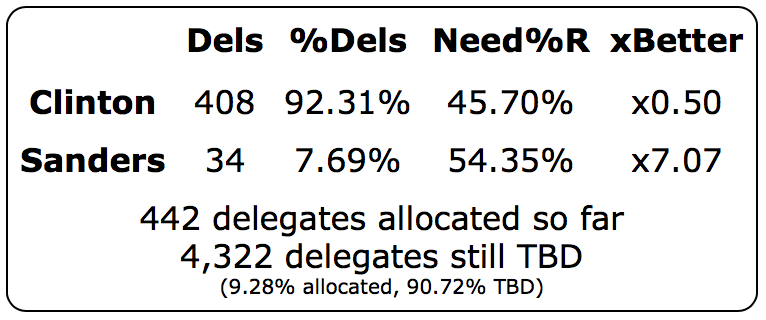
As of my post-Iowa summary post, Sanders needed 54.30% of the remaining delegates to catch up. That is now up to 54.36%.
In terms of New Hampshire specifically, this doesn’t matter of course. Either way Sanders needs 14 of the 24 delegates that will be allocated based on the primary in order to be on a pace to catch Clinton.
Five days until New Hampshire.
Note: This post is an update based on the data on ElectionGraphs.com. Election Graphs tracks both a poll based estimate of the Electoral College and a numbers based look at the Delegate Races. All of the charts and graphs seen in this post are from that site. Additional graphs, charts and raw data can be found there. All charts above are clickable to go to the current version of the detail page the chart is from, which may contain more up to date information than the snapshots on this page, which were current as of the time of this post. Follow @ElectionGraphs on Twitter or like Election Graphs on Facebook to see announcements of updates or to join the conversation. For those interested in individual general election poll updates, follow @ElecCollPolls on Twitter for all the polls as they are added.
We made it past Iowa! We have Iowa results! We have brand new speculation about New Hampshire and beyond! Yes, of course, the bulk of this week’s Curmudgeon’s Corner podcast is Sam and Ivan discussing where the presidential race sits in this week between Iowa and New Hampshire. We go over all of the results so far, then discuss how candidates, the media and the public are reacting to those results, and what that means for the rest of the contest. Plus, for the first time in a little while, we do a lightning round as well, covering bluetooth audio issues, Iran, the Flint water crisis, tech earnings results, and more!
Click below to listen or subscribe… then let us know your own thoughts!

Recorded 2016-02-04
Length this week – 2:12:09
 1-Click Subscribe in iTunes 1-Click Subscribe in iTunes
 View Podcast in iTunes View Podcast in iTunes
 View Raw Podcast Feed View Raw Podcast Feed
 Download MP3 File Download MP3 File
 Follow the podcast on Facebook Follow the podcast on Facebook
Show Details:
- (0:00:10-0:05:11) Intro
- Pi O’Clock Again
- Agenda
- Talking Politics
- (0:06:00-0:29:42) Republicans in Iowa
- Loser.com
- Headlines
- Delegate Totals
- Spin
- Polling Wrong?
- People Dropping Out
- Carson/Cruz blow up
- Speeches
- (0:30:45-0:43:55) Democrats in Iowa
- Close Race
- Not a Surprise
- Delegate Totals
- Spin
- Demographic Split
- (0:44:33-1:24:33) Republicans in New Hampshire and beyond
- Delegate Rules
- Delegate Hypothetical
- Will we get good New Hampshire polls?
- Contest Calendar
- Trump reacts to losing
- How will New Hampshire react to Iowa?
- Divided anti-Trump vote
- Trump Strategy
- Bush done?
- Big last minute moves?
- Gilmore
- post-New Hampshire
- Predictions
- (1:25:53-1:42:08) Democrats in New Hampshire and beyond
- Sanders will win New Hampshire
- post-New Hampshire
- Delegate Allocation
- How will Clinton react to losing?
- No Clinton Backup
- Clinton emails
- Clinton collapse scenarios
- (1:43:24-2:11:49) Lightning Round
- Car Bluetooth Audio
- Movie: Thomas and the Magic Railroad (2000)
- Iran Deal Implementation
- Flint Water Crisis
- Oregon Militia Standoff Ended
- Apple Earnings
- Alphabet Market Cap
- Feedback on Performance Reviews
- Feedback on Sam’s Writing
- Growing Show
|
|



















